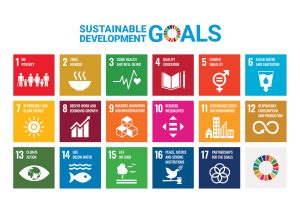Chaminade celebrated Sustainable Development Goals (SDG) Action and Awareness Week this week, which the United Nations Association of Chaminade (UNAC) Club has arranged. On Monday, the UNAC Club hosted its first event, Threads and Thrills.
Threads and Thrills took place on the Sullivan Family Library Lawn. The fashion upcycling workshop encouraged students to bring old or unused clothes and swap or alter them. During the event, students could alter their clothes or clothes they swapped by embroidering or painting them. All the clothes that were not swapped or altered were then donated to Goodwill.

The UNAC Club educates and addresses the SDG goals here at Chaminade. They strive to bring more awareness and education on the SDGs.
“SDG Action and Awareness Week is to promote awareness of the Sustainable Development Goals, which a lot of people don’t know about, and we also want to insight people to take action towards those SDGs,” said Jasmine Mondelo, the UNAC club president and a second-year majoring in accounting.
The SDGs were created at the United Nations Conference on Sustainable Development in Rio de Janeiro in 2012. The SDGs consist of 17 interconnected goals, meaning success in one affects success for others. These goals cover poverty, inequality, climate change, environmental degradation, peace, and justice. The United Nations strives to reach these goals by 2030.
“With fast fashion, there is a lot of waste consumption,” Mondelo said. “In the landfills, there are a lot of clothes that are left unused that get thrown in the trash, and with this workshop, we want to show that you don’t have to throw away those clothes, you can give them to someone else or alter them.”
As stated by Earth.org, the number of times a garment is worn has declined by around 36% in 15 years. The throwaway culture has worsened progressively over the years.

This increase is due to fast-fashion companies that have developed over the years, like Shein and Temu. Fast-fashion sites like these make it convenient for consumers to buy from them. These companies have apps that allow consumers to buy right at their fingertips.
According to Earthday.org, fast fashion is new, trendy clothing sold at a low cost and designed to be worn just a few times. With fast fashion, consumers can see an item of clothing worn on the runway or the red carpet and then purchase it online at lightning speed. Shein, one of the most prominent names in fast fashion today, adds an average of 6,000 new styles to its site daily, giving consumers an endless stream of new items to shop for. Consumers can now purchase clothing faster, cheaper, and more conveniently than ever before.
“I like the sense of community,” said Cade Garcia, a third-year at Chaminade. “I enjoy feeling like I’m helping my community by upcycling clothes.”

According to Earth.org, of the 100 billion garments produced each year, 92 million tonnes end up in landfills. This means that the equivalent of a rubbish truck full of clothes ends up on landfill sites every second.
“If you want to make a positive environmental social impact in the Chaminade community, come to our events to make a difference starting here,” said Mondelo.
